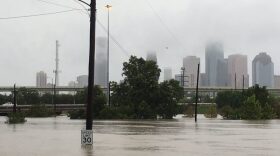The National Oceanic and Atmospheric Administration came out with an analysis this fall that found Austin and other parts of the state should expect more flooding in the future. And, as it turns out, Texas may see even more flooding than the Atlas 14 study suggests.
If you have a mind for numbers, Atlas 14 is pretty straightforward: It gives odds of storms happening in different places in different time frames. For example, the report may tell you your city’s annual odds of receiving, say, 13 inches of rain fall in the course of 12 hours.
Those numbers are important. Cities and towns use them to assign flood risk, and that dictates everything from infrastructure spending to public safety policy to building regulations.
Flood risk is "really just probability," says Texas State Climatologist John Nielsen-Gammon. "It’s like a roulette wheel. You can’t guarantee when your number is going to come up.”
So how does Atlas 14 determine risk? By looking at past rainfall.
The last federal study like Atlas 14 was released in 1961. That means the report released in September includes nearly 60 years of new rainfall data. There have been more extreme storms over that time, which is one reason the study shows greater storm and flood risk.
That's also where climate change comes in.
“The change in climate is getting baked into these new numbers,” says Victor Murphy, a climate service program manager with the National Weather Service in Fort Worth.
Here’s how: Scientists know that the Earth's warming atmosphere is causing more extreme storms. But, those more recent climate-influenced storms had not been part of the historical data. Now that those storms are included, the greater risk has become apparent.
Hurricane Harvey is a good example, Murphy says.
“These heavy rain events, they don’t happen every day, every month or even every year,” he says. “But the odds are you’re going to see more of them.”
As troubling as the findings of Atlas 14 may be for communities preparing for flooding, the study may still underrepresent the risk of climate-driven storms in some parts of Texas.
One reason is that it still includes rainfall data from a time when climate change was not having as pronounced an impact on the weather.
“The numbers are assessments of the risk over the past 100, 120 years,” Nielsen-Gammon says. “So, in fact, given climate change, they underestimate the current likelihood of flooding in general.”










